Porrhothele antipodiana
Porrhothele antipodiana, the black tunnelweb spider, is a spider found throughout much of New Zealand and the Chatham Islands in bush and gardens and is one of New Zealand's most researched spiders.[1] It is related to tarantulas, and is a harmless relative of the venomous Australian funnel-web spider.[2]
| Porrhothele antipodiana | |
|---|---|
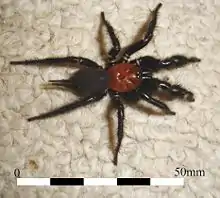 | |
| Scientific classification | |
| Kingdom: | Animalia |
| Phylum: | Arthropoda |
| Subphylum: | Chelicerata |
| Class: | Arachnida |
| Order: | Araneae |
| Infraorder: | Mygalomorphae |
| Family: | Porrhothelidae |
| Genus: | Porrhothele |
| Species: | P. antipodiana |
| Binomial name | |
| Porrhothele antipodiana (Walckenaer, 1837) | |
| Synonyms | |
|
Mygale antipodiana Walckenaer,1837 | |
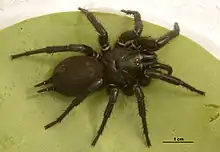
Description
In females, the carapace is usually coloured yellow or orange black with some shading near the eyes. The legs and palps are also typically orange brown, but are darker than the carapace. The chelicerae are reddish brown (sometimes black). The sternum is a pale reddish brown. The abdomen is a uniform purple black colour and may have faint chevron patterns, more noticeable in juveniles. The opening of the two pairs of book lungs are ringed with cream. Females are the larger of the two sexes.[3] Body size is variable, but can exceed 30 mm.[3][4]
In males, the carapace is darker than in females. The legs and palps are a dark reddish brown. The chelicerae are also dark reddish brown and sometimes black. The abdomen is also coloured similarly to that of females.[3]Males can be distinguished from females by the presence of clasping structures in the first pair of legs which are used to hold females during copulation.[5]
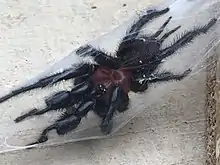
Porrhothele antipodiana is often confused with species from the genus Hexathele, which occupies similar habitat and builds similar webs. They can be distinguished by the number of spinnerets (Porrhothele has two sets of spinnerets whereas Hexathele has three sets).[3]
As the common name suggests, these spiders construct non-sticky long tunnel-shaped webs, often under logs and rocks, but they will also construct their webs in the trunks of trees, in rock faces and in urban structures.[6] Tunnels may be up to 25 cm long and 3-4 cm wide, often with just a single opening where silk is widely spread out to catch and alert the spiders to the presence of prey.[7] Webs for tunnels can be spun as quickly as within one hour.[8]
Taxonomy
Porrhothele antipodiana was first described in 1837 by Charles Athanase Walckenaer, a French entomologist and arachnologist who described a specimen from New Zealand as Mygale antipodiana.[9] This was one of the earliest description of a species of spider in New Zealand.[1] In 1849, Adam White described two species of Mygale (Ctenzia) that were endemic to New Zealand. These were Mygale (Ctenzia) antipodium and Mygale (Ctenzia) hexops. White noted that Mygale hexops had only six eyes, rather than eight, which is typical for Porrhothele antipodiana.[10] It is not known if this is a mistake or not. In the same year, Mygale quoyi was described by Hippolyte Lucas, named after the collector of the specimen used for description.[11]In 1871 Mygale (Ctenzia) hexops was moved to the Hexops genus and subsequently named “Hexops whitei” by Anton Ausserer. The creation of this genus was done on the basis that Mygale (Ctenzia) hexops was described as having only six eyes, which is unique among other specimens of Mygalomorphae in the area.[12]In 1873, Reverend Octavius Pickard-Cambridge described a new species found in Wellington from the recently described Macrothele genus, and named this species Macrothele huttoni.[13] In 1891, Eugène Simon recognized Mygale quoyi as a synonym of Mygale antipodiana and also described both male and female specimens of a new species named "Macrothele insignipes".[14] However, a year later, Simon created a new genus for Mygale antipodiana, so the species became Porrhothele antipodiana. In addition to this, Simon recognized Macrothele insignipes as a synonym of Porrhothele antipodiana.[15]
In 1894, Arthur Urquhart described a new species in the genus Nemesia (a member of the trapdoor spider family), he named this species "Nemesia kirkii" after the collector of this specimen.[16] In 1901, Henry Hogg provided another description of Porrhothele, and distinguished it from Macrothele on the basis of the lack of spines on the tarsi and much stouter front legs. On this basis, Hogg recognized that Macrothele huttoni was actually an immature Porrhothele antipodiana and thus had Macrothele huttoni recognized as a synonym. In his description, Hogg also described Porrhothele simoni, a species that would later be recognized as another synonym of P. antipodiana. Hogg also moved Nemesia kirkii into the newly formed Arbanitis genus.[17]
In 1945, Valerie Todd Davies provided another description of Porrhothele antipodiana but also suggested that Porrhothele simoni should be considered a synonym of P. antipodiana.[8] P. simoni was originally distinguished by the colour of the thorax, space in between fore median eyes and curvature of the fovea.[17] Davies argued that space between eyes can vary with age and that thorax colour is very variable, so the only distinguishing feature to consider is the curvature of the fovea, which would put the validity of this species into question. Davies also described a new species of Porrhothele, named Porrhothele avocae, which was described only from species found at Mount Arthur Pass.[8]
In 1968, P. antipodiana was given an updated description by Raymond Forster and P. avocae was recognized as a synonym of P. antipodiana. Forster also suggested that P. antipodiana may actually represent many morphologically very similar (i.e. cryptic) species that have not yet been described.[3][1]
Distribution and habitat
Porrhothele antipodiana is the most widespread species of Porrhothele and is found throughout both main islands of New Zealand. In the North Island, it appears to be excluded from the Northland region (where Porrhothele quadrigyna is known to be distributed). It seems to be broadly distributed in the South Island, except for in the alpine zone. P. antipodiana is also known to occur in the Chatham Islands, but this is thought to be a recent human-mediated introduction.[3][1]
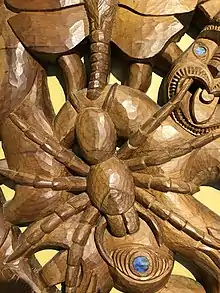
Porrhothele antipodiana occupies a variety of habitats. They are typically found under old logs and rocks but will also set up webs in cliffs and rock faces where possible. They typically occur in forests, but are also known to occur in sand dunes, gardens and hillsides with clusters of rocks.[3][18][19]
Life history
When laid, eggs are loosely packed together in cocoons which have two thin layers of silk.[8][3] Eggsac construction occurs from late October to mid-December (during the summer). Estimates of the number of eggs in their eggsacs range from 100-300.[19] Eggs may take up to 30 days to hatch after laying (this seems to occur when the spiderlings reach 2-3 mm in length), with the spiderlings moulting for the first time a few days later. The spiderlings remain within the female's nest until they develop further. During the first instar period, the spiders are inactive and lay on their backs stretching their limbs, then moulting after five weeks. The second instar spiders are more active and begin spinning webs and feeding.[8][3][19]The spiderling tends to grow to a length of 12mm by the end of the first year. After 2-3 years, the spider reaches maturity. When at maturity, the spider will continue to sporadically moult.[3][19]P. antipodiana is relatively long lived and is known to live for at least six years.[19]
Behaviour
Courtship and copulation
As the male approaches the female's web platform, the front pair of legs are raised, which aims the modified metatarsus and tibia (claspers) at the female. The cephalothorax is also aimed upwards, revealing his fangs and palps. The front pair of legs are used to vibrate the web as the male moves forwards towards the female. The male then uses his claspers to clasp the female's two palps, which causes the female to enter a passive state. The male then pushes the limp female in a position where the cephalothorax of the male is perpendicular to the underside of the female's cephalothorax. If on the web, the female may also lay on her back. The male then copulates with the female by injecting sperm into the female reproductive tract using one palp at a time. Copulation concludes when the male (whilst still clasping the female) disengages and then pushes the female away. During courtship and copulation, males spin silk.[5][7][20]
Prey
Like almost all spiders, Porrhothele antipodiana is an obligate carnivore. The remains of the captured prey end up spread throughout the web, so it can be easy to identify what the spider has been feeding on. These spiders seem to feed on almost anything that happens to come close enough to its web, so its prey may simply reflect what species happen to be present in the area. A small selection of prey that have been preyed upon by P. antipodiana includes Porcellio scaber, bumblebees, Holcapsis, Xyloteles and Dolomedes.[21]
One of the most unusual prey species of P. antipodiana is the snail Cornu aspersum (which is exotic to New Zealand). This is quite a difficult prey for most spiders to catch since they have a hard shell they can retreat into and slime that can be produced. To kill the snails, P. antipodiana first detects and embeds its fangs into the flesh of the snail. The spider then attempts to keep its fangs embedded as the snail retracts into its shell. While attached, the snail begins to produce abundant amounts of foam in an attempt to deter the spider. Although the snails appear to be resistant to the venom of the spider, they eventually die after about 30 minutes. The spider may then spend many hours feeding on the snail.[22]
Another notable prey item is Vespula germanica, another exotic species in New Zealand. The aggressive behaviour of this species could be expected to make it difficult for a P. antipodiana to safely capture. Once the wasp becomes entangled in web, the spider grabs the wasp from behind the thorax (to avoid the stinger) and then kills it.[21]
Natural predators
Porrhothele antipodiana is known to be preyed upon by the North Island brown kiwi.
Parasites
Porrhothele antipodiana is known to be parasitized by Aranimermis giganteus, a nematode that parasitizes the Mygalomorphae of New Zealand. Individuals infected with the parasite seem to become attracted to water, which inevitably causes them to drown, allowing the A. giganteus to complete the aquatic stage of its life cycle.[23]
Interactions with spider-hunting wasps
A considerable source of mortality in these spiders can be attributed to spider-hunting wasps, especially Priocnemis monachus. These wasps are specialized for hunting large spiders, which they paralyze and lay eggs in, which then hatch and consume the spiders body.[24]
Once these wasps locates the spider's burrow, they enter and corner the spider. The spider will then rear up into a defensive posture, but the spider is usually stung several times during the struggle and is paralyzed. Since the spider is much larger than the wasp, it has to be dragged backwards towards the wasps nest. Once placed in the nest, an egg is laid on the spider and this eventually hatches and feeds on the spider.[24]
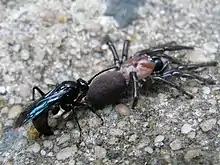
Interactions with mice
New Zealand is home to many invasive mammalian species, including mice. In its regular habitat, Porrhothele antipodiana is likely to be encountered by mice and other introduced mammals, and could be potential prey. P. antipodiana placed into containers with mice assumed a defense threat posture when investigated by the mice. The mice would then attack with "a series of quick, darting rushes, nipping at the outstretched legs of the spider". During this, the spider would strike at the mice, but the mice would generally avoid these strikes. As this continued, the spider would tire when pieces of leg were ripped off, which caused body fluid to spill out, which led to the spider dying. The mice would then proceed to eat the abdomen and cephalothorax of the spider. However, in some encounters, the spiders would catch hold of the mouse and bite it, causing it to lose orientation, shiver and ultimately die. Mice that survived bites would later avoid attacking these spiders.[18]
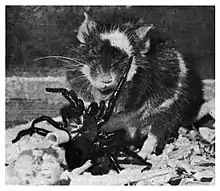
Interactions with humans
Porrhothele antipodiana may bite a human if it feels threatened. Since these spiders may occupy gardens, an encounter with an unaware human may occur and a bite may happen, although this is rare. Bites are painful and may cause localized swelling, itching, or numbness. Bites may leave two small punctures in the skin. There is only one known case of serious symptoms occurring, which were likely to be due to secondary infection.[7] Victims are advised to disinfect the area to reduce the risk of infection. The venom is not dangerous to humans.[25]
In Maori culture
It has been suggested that the word "kahuwai", which refers to an unidentified species of spider in Maori literature, refers to Porrhothele antipodiana.[26]
In popular culture
This spider was described by director Peter Jackson as the inspiration for his depiction of Shelob in his The Lord of the Rings film adaptation.[27]
References
- Vink, Cor J. (2017-07-03). "A history of araneology in New Zealand". Journal of the Royal Society of New Zealand. 47 (3): 262–273. doi:10.1080/03036758.2017.1334676. ISSN 0303-6758.
- Te Ara - The Encyclopedia of New Zealand - Story: Spiders and other arachnids - Tunnel-web spider
- Forster, R. R. (1968). The spiders of New Zealand. Part II. Ctenizidae, Dipluridae. Otago Museum Bulletin 2: 1-72, 126-180.
- "T.E.R:R.A.I.N - Taranaki Educational Resource: Research, Analysis and Information Network - Tunnelweb spider (Black) Porrhothele antipodiana". www.terrain.net.nz. Retrieved 2019-08-26.
- Jackson, Robert R.; Pollard, Simon D. (1990-10-01). "Intraspecific interactions and the function of courtship in mygalomorph spiders: a study of Porrhothele antipodiana (Araneae: Hexathelidae) and a literature review". New Zealand Journal of Zoology. 17 (4): 499–526. doi:10.1080/03014223.1990.10422949. ISSN 0301-4223.
- Hallas, S. E. A.; Jackson, R. R. (1986-08-01). "Prey-holding abilities of the nests and webs of jumping spiders (Araneae, Salticidae)". Journal of Natural History. 20 (4): 881–894. doi:10.1080/00222938600770651. ISSN 0022-2933.
- Forster, Ray; Forster, Lyn (1999). Spiders Of New Zealand And Their World Wide Kin. Otago, New Zealand: University of Otago Press. pp. 119–124. ISBN 1 877372 13 7.
- Todd, V. (1945). Systematic and biological account of the New Zealand Mygalomorphae (Arachnida). Transactions and Proceedings of the Royal Society of New Zealand 74: 375-407.
- Walckenaer, C. A. (1837). Histoire naturelle des insectes. Aptères. Paris 1, 1-682.
- White, A. (1849). Descriptions of apparently new species of Aptera from New Zealand. Proceedings of the Zoological Society of London 17: 3-6. (reprinted in Ann. Mag. nat. Hist. (2) 5: 50-53, 1850)
- Lucas, H. (1849b). Articles sur les araignées. In: Dictionaire Universel d'Histoire Naturelle. Paris.
- Ausserer, A. (1871a). Beiträge zur Kenntniss der Arachniden-Familie der Territelariae Thorell (Mygalidae Autor). Verhandlungen der Kaiserlich-Königlichen Zoologisch-Botanischen Gesellschaft in Wien 21: 117-224, pl. I. [incl. unpubl. manuscript by Doleschall]
- Pickard-Cambridge, O. (1873h). An introduction to the study and collection of the Araneida of New Zealand. With a description and figures of Cambridgea fasciata L. Koch from Chatham Island; and also of a new species of Macrothele Auss., M. huttonii Cambr., found at Wellington, New Zealand. Transactions of the New Zealand Institute 6: 187-207.
- Simon, E. (1891e). Etudes arachnologiques. 23e Mémoire. XXXVIII. Descriptions d'espèces et de genres nouveaux de la famille des Aviculariidae. Annales de la Société Entomologique de France 60: 300-312.
- Simon, E. (1892a). Histoire naturelle des araignées. Deuxième édition, tome premier. Roret, Paris, pp. 1-256. [second pdf with detailed publication dates of the single parts] doi:10.5962/bhl.title.51973
- Urquhart, A. T. (1894). Description of new species of Araneae. Transactions of the New Zealand Institute 26: 204-218.
- Hogg, H. R. (2010-07-07). "On Australian and New Zealand Spidera of the Suborder Mygalomorphae1". Proceedings of the Zoological Society of London. 71 (1): 218–284. doi:10.1111/j.1469-7998.1901.tb08176.x.
- Laing DJ. 1975. The postures of the tunnel web spider Porrhothele antipodiana: a behavioural study. Tuatara. 21:108–120.
- Laing, D.J. (1978). Studies on populations of the tunnel web spider Porrhothele antipodiana- Part 1: Characteristic features and seasonal changes. Tuatara, 23(2).
- Scott, Catherine E.; Anderson, Alissa G.; Andrade, Maydianne C. B. (2018/08). "A review of the mechanisms and functional roles of male silk use in spider courtship and mating". The Journal of Arachnology. 46 (2): 173–206. doi:10.1636/JoA-S-17-093.1. ISSN 0161-8202
- Laing, D.J. "Prey and prey capture in the tunnel web spider Porrhothele antipodiana". Tuatara. 20 (2).
- Laing, D.J. "Snail eating behaviour of the tunnel web spider Porrhothele antipodiana (Mygalomorphae: Dipluridae)". Tuatara. 25 (2).
- Poinar, G.O. & Early, J.W. (1990). Aranimermis giganteus n. sp. (Mermithidae : Nematoda), a parasite of New Zealand mygalomorph spiders (Araneae : Arachnida). Revue Nématol. 13(4): 403.410.
- Harris, AC 1987. Pompilidae (Insecta: Hymenoptera). Fauna of New Zealand 12, 160 pages. (ISSN 0111-5383 (print), ; no. 12. ISBN 0-477-02501-3 (print), ). Published 13 Nov 1987. ZooBank: http://zoobank.org/References/A9438A0B-3735-4A7A-B898-63DB542F9084
- New Zealand National Poisons Centre
- Miller, D. (1952). The insect people of the Maori. The Journal of the Polynesian Society, 61(1/2): 1-61.
- Rob Suisted
External links
- Pictures of eggsac
- Black tunnelweb spider on the website of the Museum of New Zealand Te Papa Tongarewa
- Tunnel-web spider at Te Ara - The Encyclopedia of New Zealand
| Wikimedia Commons has media related to Porrhothele antipodiana. |